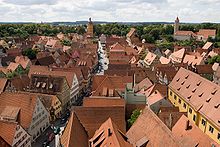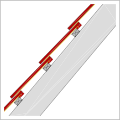Beaver tail
The beaver tail is a flat roof tile that is often semicircular at the lower edge . Its shape is reminiscent of the tail ( waidm .: The trowel ) of the eponymous animal , as it ends in a curve and is halved in the middle by a slightly raised line. Near the upper edge, the beaver tail has a protrusion (the nose) with which it is attached to the roof batten . In addition to the above-mentioned semicircular shape of the lower edge, plain tiles traditionally come in numerous other variants, e.g. B. with a segment arch , with a straight end, curved or tapered ("Rautenspitzbiber"). Each of these shapes creates a different, characteristic structuring of the roof surface.
History of the beaver tail
There are indications that the roof tile shape beaver tail originated in the 14th century in the clay pits around Nuremberg . Large parts of Nuremberg's old town, including the city wall and Nuremberg Castle , are covered with bricks that show the medieval forms of this type of brick. These are probably the oldest houses in Germany that are covered with bricks of this type. The beaver tail tiles replaced the monk-and-nun- shaped tiles known from the Romans .
Deck types


The beaver tail is placed on the roof structure in two overlapping layers, each offset by half a tile, and adheres very well even to extremely steep roofs without additional anchoring. This creates the typical "fish scale impression". A distinction is made between three traditional types of decking, of which only two are used today.
Crown coverage
With the crown covering, both tile layers are hung on the same roof batten so that the lower layer is almost completely covered by the upper layer. The lower layer is called the bearing layer . The top layer is required to cover the underlying joint of the bearing layer .
Double coverage
With double roofing, each tile layer is laid on its own roof batten in such a way that the lower layer is covered by a little more than half. As a result, the upper edge of the first layer is still covered by the lower end of the third layer. The joints on the eaves and ridge would be unprotected, so that with the double covering, the ridge and eaves rows still have to be covered with crowns. This must be taken into account when dividing the roof area if the cover image is to look uniform over the entire roof area.
If carried out correctly, both types of cover ensure that rainwater cannot penetrate the building through the longitudinal joint between the bricks, but is drained off via the brick below.
Single coverage
In particular, historical farm buildings and farmhouses can also be covered with single splines . This coverage is "half" double coverage. Every second row is missing for double coverage. Single covering is very easy, as only half of the beaver tails are required compared to double covering or crown covering. Since rainwater can penetrate through the longitudinal joint with the single covering, so-called splines or shavings or shingles made of wood, plastic or aluminum are placed under the longitudinal joints .
In the meantime there is also a variant available on the market as a folded plain tile . This species of beaver can be laid with normal single cover. However, only on straight surfaces. The Falzbiber loses its flexibility when laying valleys, bat dormers and other curved roof shapes. The so-called tower beaver is a narrower and, above all, shorter version of the beaver tail tile .
Single covering: The longitudinal joints between the bricks are underlaid with slats or cardboard docks .
Cut shapes
- Round cut beaver
- Segment cut beaver
- Straight cut beaver
- Straight cut beaver with rounded corners
- Hexagonal beaver
- Tower beaver
- Gothic beaver
- Heraldic beaver
Spread and future

The beaver tail can be seen as the German brick par excellence. In southern Germany and East Germany as well as in the southern and eastern neighbors of Germany he reached the widest distribution. Many houses in Mecklenburg are covered with beaver tails. In West Germany , on the other hand, beaver tail tiles are rather rare.
Compared with other tiles or roof tiles, e.g. B. the " Frankfurter Pfanne ", the beaver tail covering means higher material consumption and thus higher costs. When new roofs are covered, the use of the beaver tail therefore decreases; However, it is still used for renovations of listed secular and church buildings in order to preserve or restore the historically correct overall impression. Here, too, the exception is the beaver, which, with a single covering, does not use more material than other types of brick.
Monument authorities often prefer plain tiles with the less pronounced segment arch, basket arch or other regional special shapes compared to the standard tile with semicircular arch.
literature
- Herbert Wartmann: Technique of the beaver tail covering . Müller, Cologne 1998, ISBN 978-3-481-01152-9 ; 2nd edition: The technique of beaver tail covering in the picture , Müller, Cologne 2001, ISBN 978-3-481-01862-7 .
- Willi Bender: Lexicon of bricks. From the eel ceiling tile to the partition wall tile in words and pictures; with a dictionary of the brick names German / English, English / German . 2nd Edition. Bauverlag, Wiesbaden / Berlin 2001, ISBN 3-7625-3156-0 .
Web link
Individual evidence
- ↑ "Falzbiber" in the archive of historical roof tiles , Bundesverband der Deutschen Ziegelindustrie e. V., Bonn.
- ↑ dach-zentrum.de: roofs and monument preservation; Roof details: Page 6 ( Memento from October 11, 2014 in the Internet Archive ) (PDF; 1.5 MB)
- ^ Mittag, Martin, Bau Konstruktionslehre, Bertelsmann Verlag, Gütersloh 1952









